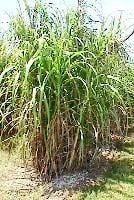Kingdom Plantae Family Poaceae Rank Species | Order Poales Genus Saccharum | |
 | ||
Similar Saccharum edule, Saccharum spontaneum, Andropogoneae, Saccharum bengalense, Puccinia melanocephala | ||
Saccharum barberi is a strong-growing species of grass in the genus Saccharum, the sugarcanes. It originates from northern India and has been exported to other countries and grown for the production of sugar. The species name commemorates C.A. Barber.
Contents
Description
Saccharum barberi is a perennial plant with a short robust rhizome. The many erect canes have a maximum diameter of 2.5 cm (1 in) and the leaf blades a maximum width of 5 centimetres (2.0 in). The flower is a large panicle with long silky hairs on the stalk which soon break off. The spikelets are in pairs, one with a short stalk and the other without. The canes have a moderate sugar and a high fibre content.
Distribution
Saccharum barberi originated in northern India and has been exported to other parts of the world. At one time it was the major species cultivated in North America. It needs a growing temperature of 20 °C (68 °F) to 32 °C (90 °F) and 1,200 to 1,500 millimetres (47 to 59 in) of rain.
Uses
Saccharum barberi is cut and processed to extract sugar. The remaining parts of the plant have many uses. The crop residue is known as bagasse and is used for feeding livestock and as fuel. It is processed into fibreboard and paper and used to make furfural, cellulose and plastics. Molasses is formed during the refining process and is used in the manufacture of confectionery products, rum, gin and industrial alcohol. A wax is extracted from the plant and used to make shoe and furniture polish, waxed paper and electrical insulation. Filter mud cake, a solid byproduct of the refining process is mixed with fertilizers and used for soil improvement.
